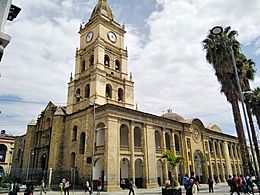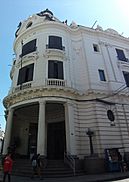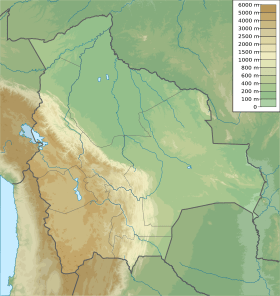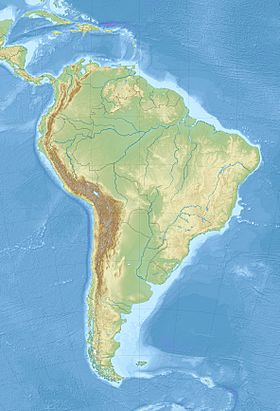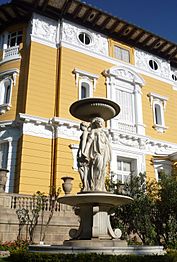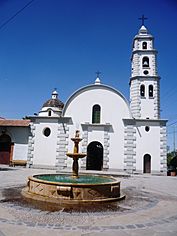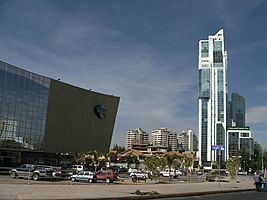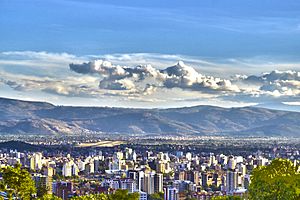Cochabamba facts for kids
Quick facts for kids
Cochabamba
Quchapampa
|
|||
|---|---|---|---|
|
City & Municipality
|
|||
|
From the top to bottom, left to right: Metropolitan Cathedral, Palacio Portales, Templo del Hospicio, Aerial view of central Cochabamba, Tunari mountains, Banco Mercantil Simon Patiño, Cochabamba seat of government
|
|||
|
|||
| Nicknames:
"City of Eternal Spring"
"The Garden City" "La Llajta" |
|||
| Country | |||
| Department | Cochabamba | ||
| Province | Cercado Province | ||
| Municipality | Cochabamba Municipality | ||
| Founded | August 15, 1571 | ||
| Government | |||
| • Type | Municipal Autonomous Government | ||
| Area | |||
| • City & Municipality | 170 km2 (70 sq mi) | ||
| • Land | 169 km2 (65 sq mi) | ||
| • Water | 1 km2 (0.4 sq mi) | ||
| • Urban | 111 km2 (43 sq mi) | ||
| Elevation | 2,558 m (8,392 ft) | ||
| Population
(2012 Census)
|
|||
| • Urban | 856,198 | ||
| • Metro | 1,430,688 | ||
| Demonym(s) | Cochabambino | ||
| GDP (PPP, constant 2015 values) | |||
| • Year | 2023 | ||
| • Total (Metro) | $11.8 billion | ||
| • Per capita | $8,400 | ||
| Time zone | UTC-4 (BOT) | ||
| Climate | BSk | ||
| Website | Official website: https://www.cochabamba.bo/ | ||
Cochabamba (Aymara: Quchapampa; Quechua: Quchapampa) is a lively city and municipality in central Bolivia. It sits in a beautiful valley within the Andes mountain range. It's the capital of the Cochabamba Department and the fourth-largest city in Bolivia. In 2012, its population was over 630,000 people.
The city's name comes from the Quechua words qucha (meaning "lake") and pampa (meaning "open plain"). People who live here are often called cochalas or cochabambinos.
Cochabamba is famous for its pleasant weather all year round, earning it nicknames like "City of Eternal Spring" or "The Garden City." It's also known as "La Llajta," which means "town" in Quechua. The city is an important center for culture, education, and business in Bolivia. Long ago, the area had many lakes, which is how it got its name. Today, some lakes like Coña Coña and Alalay still exist.
Contents
- History of Cochabamba
- What's the Climate Like in Cochabamba?
- People and Culture in Cochabamba
- Cochabamba's Economy
- Getting Around Cochabamba: Transport
- Basic Services in the City
- Media in Cochabamba
- Education in Cochabamba
- Cochabamba's Airport
- Exploring Cochabamba's Neighborhoods
- Cochabamba's Metropolitan Area
- Famous People from Cochabamba
- Cochabamba's Sister Cities
- Images for kids
- See also
History of Cochabamba
Early Times: Pre-Inca and Inca
The Cochabamba valley has been home to people for thousands of years. This is because of its rich soil and mild climate. Archaeological findings show that different groups like the Tiwanaku, Tupuraya, and Inca lived here before the Spanish arrived.
The Inca ruler Topa Inca Yupanqui (who ruled from 1471–1493) conquered the area. His son, Huayna Capac, turned Cochabamba into a huge state farm. They grew a lot of maize (corn) here, which was important because it couldn't grow in the colder parts of the Inca Empire. This maize was stored in many storehouses (qollqas) or sent by llama caravans to other Inca centers. It likely helped feed the Inca army.
Spanish Rule and Bolivian Independence
The first Spanish person to live in the valley was Garci Ruiz de Orellana in 1542. He bought most of the land from local leaders. His old home, called the House of Mayorazgo, is still standing today.
The city, first named Villa de Oropesa, was officially founded on August 2, 1571. It was meant to be a farming center, providing food and wood for the mining towns nearby, especially Potosí. Potosí was one of the biggest and richest cities in the world in the 16th and 17th centuries because of its silver mining. So, Cochabamba grew and did well during this time. However, when silver mining slowed down in the 18th century, Cochabamba also faced a difficult period.
In 1786, the King of Spain, Charles III of Spain, called Cochabamba the "loyal and valiant" city. This was because the city helped stop local uprisings in 1781. Since the late 1800s, Cochabamba has once again become a successful farming center for Bolivia.
A count in 1793 showed that the city had 22,305 people. This included mestizos (people of mixed Indigenous and Spanish background), Spaniards, Indigenous people, and mulattos.
In 1812, Cochabamba was the site of a brave protest against the Spanish army. On May 27, thousands of women fought against the Spanish forces. They showed incredible courage, even though they were outnumbered. To honor their bravery, Bolivia now celebrates May 27 as Mother's Day.
The Water War: A Fight for Water
In 1998, Bolivia received a loan from the International Monetary Fund (IMF). One condition of the loan was that Bolivia had to sell its public companies, including the local water company, SEMAPA. In 1999, a group of private companies, including Bechtel Corporation, bought the rights to manage the city's water.
Soon after, in 2000, water prices went up by 50%. Many people in Cochabamba could not afford this increase. So, they started to protest. A group called the Coalition for the Defense of Water and Life, led by Oscar Olivera, organized demonstrations. The protests were meant to be peaceful, but police used tear gas, and some people were injured.
News about the protests and the violence spread. The Coalition held a vote, and most people wanted the water company's contract to end. The government refused at first, but the protests grew bigger. Eventually, the private company left, and SEMAPA was returned to public control. This event became known as the "Water Wars." It showed the world the importance of water access and influenced later decisions about water being a human right.
What's the Climate Like in Cochabamba?
Cochabamba is famous for its "Eternal Spring" weather. It doesn't get the hot, humid weather of Santa Cruz or the very cold winds of La Paz. Instead, Cochabamba has a semi-arid climate (which means it's mostly dry but not extremely hot).
The city has a long dry season from May to October. The wet season usually starts in November, with most of the rain falling until March.
| Climate data for Cochabamba (Jorge Wilstermann International Airport), elevation 2,548 m (8,360 ft) | |||||||||||||
|---|---|---|---|---|---|---|---|---|---|---|---|---|---|
| Month | Jan | Feb | Mar | Apr | May | Jun | Jul | Aug | Sep | Oct | Nov | Dec | Year |
| Record high °C (°F) | 35.0 (95.0) |
33.5 (92.3) |
34.0 (93.2) |
33.4 (92.1) |
32.6 (90.7) |
31.5 (88.7) |
30.6 (87.1) |
32.7 (90.9) |
32.8 (91.0) |
34.5 (94.1) |
35.5 (95.9) |
34.9 (94.8) |
35.5 (95.9) |
| Mean daily maximum °C (°F) | 25.0 (77.0) |
24.8 (76.6) |
25.5 (77.9) |
26.3 (79.3) |
25.9 (78.6) |
24.9 (76.8) |
24.8 (76.6) |
25.9 (78.6) |
26.8 (80.2) |
27.8 (82.0) |
27.8 (82.0) |
26.4 (79.5) |
26.0 (78.8) |
| Daily mean °C (°F) | 18.7 (65.7) |
18.4 (65.1) |
18.4 (65.1) |
17.6 (63.7) |
15.3 (59.5) |
13.4 (56.1) |
13.4 (56.1) |
15.2 (59.4) |
17.2 (63.0) |
19.1 (66.4) |
19.8 (67.6) |
19.4 (66.9) |
17.2 (62.9) |
| Mean daily minimum °C (°F) | 12.4 (54.3) |
12.1 (53.8) |
11.3 (52.3) |
8.8 (47.8) |
4.7 (40.5) |
1.9 (35.4) |
2.1 (35.8) |
4.5 (40.1) |
7.7 (45.9) |
10.3 (50.5) |
11.8 (53.2) |
12.4 (54.3) |
8.3 (47.0) |
| Record low °C (°F) | 4.8 (40.6) |
5.1 (41.2) |
2.0 (35.6) |
−1.2 (29.8) |
−4.5 (23.9) |
−7.0 (19.4) |
−5.2 (22.6) |
−5.6 (21.9) |
−3.2 (26.2) |
0.1 (32.2) |
4.0 (39.2) |
5.0 (41.0) |
−7.0 (19.4) |
| Average precipitation mm (inches) | 117.5 (4.63) |
95.8 (3.77) |
66.9 (2.63) |
17.7 (0.70) |
3.3 (0.13) |
2.0 (0.08) |
1.8 (0.07) |
5.0 (0.20) |
8.0 (0.31) |
18.2 (0.72) |
45.8 (1.80) |
87.5 (3.44) |
469.5 (18.48) |
| Average precipitation days | 16.6 | 14.5 | 11.1 | 4.0 | 1.1 | 0.7 | 0.7 | 1.4 | 3.1 | 5.2 | 8.6 | 14.0 | 81 |
| Average relative humidity (%) | 64.2 | 65.0 | 62.9 | 57.9 | 52.2 | 51.6 | 49.9 | 47.7 | 47.8 | 47.8 | 50.4 | 56.9 | 54.5 |
| Source: Servicio Nacional de Meteorología e Hidrología de Bolivia | |||||||||||||
People and Culture in Cochabamba
| Historical population of Cochabamba | ||
|---|---|---|
| Year | Pop. | ±% p.a. |
| 1793 | 22,305 | — |
| 1835 | 14,162 | −1.08% |
| 1854 | 35,800 | +5.00% |
| 1900 | 21,886 | −1.06% |
| 1950 | 74,949 | +2.49% |
| 1967 | 137,004 | +3.61% |
| 1992 | 414,307 | +4.53% |
| 2001 | 516,683 | +2.48% |
| 2012 | 630,587 | +1.83% |
| Source: 1793, 1967; 1835; 1854, 1950; 1900; 1992; 2001; 2012 | ||
Cochabamba is known as the heart of Bolivia and its food capital! You can find many delicious traditional dishes here, like salteñas, chuño, pique macho, and silpancho.
Every two years since 2011, Cochabamba hosts the BAU (Bienal de Arte Urbano), an international street art festival. Local cultural center proyecto mARTadero organizes it. Artists from all over the world come to paint amazing murals in different neighborhoods.
Like other big cities in the Andes, Cochabamba has different areas. The central business districts, especially Zona Norte, have modern buildings and many businesses. La Cancha is a huge open-air market where locals can buy almost anything. The city also has a lively nightlife around Calle España and El Prado boulevard. In contrast, some areas like Zona Sur, near the airport, are less developed with simpler homes.
In 2009, Bolivia's government made Spanish and 36 other Indigenous languages official. In Cochabamba, Spanish and Quechua are the most spoken languages. People often mix Quechua words into their Spanish.
More people are learning English, especially in business. However, most people in Cochabamba do not speak English. About four out of five people in Bolivia are Catholic.
Cochabamba's population is made up of different groups. These include Indigenous people (mostly Quechua and Aymara), Mestizo (mixed Indigenous and Spanish), and people of Spanish or other European descent. There's also a group of Afro-Bolivians.
Cochabamba's Economy
The area around Cochabamba is often called the "granary of Bolivia" because it's great for farming. The climate is milder than the western Altiplano region, so many crops grow here. These include grains, potatoes, and coffee in the highlands. In the warmer Chapare lowlands, they grow sugar cane, cocoa beans, tobacco, and fruits.
Cochabamba is also a growing industrial center in Bolivia. It produces things like cars, cleaning products, cosmetics, chemicals, and cement. Recently, the software industry has become very important. International companies have offices here, and Cochabamba is sometimes called the "Silicon Valley of Bolivia" because of the high demand for tech professionals.
The national airline, Boliviana de Aviación, has its main office in Cochabamba. The city has also seen a lot of new construction in recent years, with many buildings being built.
Getting Around Cochabamba: Transport
The Cochabamba metropolitan area, which includes nearby towns like Vinto and Quillacollo, has a big transportation system. It covers all parts of the city and surrounding areas.
There are nearly 70 bus and minibus lines, identified by letters or numbers. There are also many "trufis" (T.RU.FI), which are shared taxis with fixed routes. These are identified by signs on their roofs showing their route and line number.
Light Rail System
A new interurban light rail network called Mi Tren (My Train) is being built. It connects Cochabamba with other towns. The first parts of the Red Line and Green Line opened on September 13, 2022.
Basic Services in the City
EMSA, the city's sanitation company, is in charge of collecting, transporting, and storing urban waste. EMSA covers most of the city and collects about 400 tons of waste every day. The city provides special containers for trash. The main waste disposal site, K'ara K'ara, has been a source of discussion about air and water pollution.
Media in Cochabamba
Newspapers
You can find several newspapers in Cochabamba:
- Los Tiempos
- Opinión
- La Voz
- Gente
Radio Stations
Many radio stations broadcast across the department and in the city:
- Estrella FM 93,1
- Centro Ltda.
- Mega DJ
- Milenio
- La Voz del Juno
- Kancha Parlaspa
- Bandera Tricolor
- Cochabamba
- Gaviota Dorada
- Del Valle
- San Rafael
- La Voz del Valle - Punata
- Continental
- Oro
- Triunfo Morena
- Epoca
- La Verdad F.M.100.7
- M&D Comunicaciones
- Universal
- Fantástico 97.1
- Panorama FM 90.9
- Punata radio Panorama FM 88.9
- FM-100 Clásica
- FM Stereo 98.7 – La voz de América
- Bethel FFM 95.5
- Ritmo 97.5
- La Triple Nueve 99.9
- La Fabrica de la Musica 107.1
- Magnal de Capinota
- Radios Fides Cochabamba, Punata y Chapare
- CEPRA Pongo Khasa 1,390 AM
- Sonido Lider 95.9 FM
- Pio XII FM 97.9
- Mundial
- Porvenir
- Radio Cosmos de Bolivia
- CEPRA - Centro de Producción Radiofónica
- CEPRA - Radio Morochota
- Enlace
- Radio HIT 105.7
- Radio Disney Bolivia
TV Channels
Many TV channels broadcast in Cochabamba, some locally and some nationally or internationally:
- Canal 2: Canal 2 Cochabamba Corazón de América (local)
- Canal 4: Red ATB (national)
- Canal 5: Red Bolivisión (national)
- Canal 7: Bolivia TV (Channel of the State)
- Canal 9: Red Uno de Bolivia (national)
- Canal 11:TVU (local)
- Canal 13:Red Unitel (national)
- Canal 15:Cristo Viene la Red (Religious Channel)
- Canal 17:sko TV (local)
- Canal 18: Radio Televisión Popular (RTP) (national)
- Canal 20: Piñami de Comunicaciones (provincial)
- Canal 21: Tele C (local)
- Canal 24: Red ADVenir Internacional (Christian Channel/International)
- Canal 26: Metro TV (local)
- Canal 27: Sistema Cristiano de Comunicaciones (local)
- Canal 30: 30 TV (local)
- Canal 36: Cadena A (national)
- Canal 39: Univalle TV (local)
- Canal 42: Red PAT (national)
- Canal 45: Abya Yala Television (national)
- Canal 48: Red Unitepc (local)
- Canal 51: MTV Cochabamba(local)
- Canal 57: RTL Canal de Noticias(local)
Education in Cochabamba
Cochabamba is home to the University of San Simón (UMSS), one of Bolivia's largest and most important public universities. It's considered one of the top universities in the country. There are also several private universities, like Universidad Privada Boliviana and Universidad del Valle. Many students from Brazil also choose to study in Cochabamba because of its good living conditions. The city also has excellent schools, such as Colegio San Agustín.
Cochabamba's Airport
Cochabamba is served by the modern Jorge Wilstermann International Airport (IATA code CBB). This airport handles both flights within Bolivia and international flights. It's where the main office of Boliviana de Aviación (BOA), Bolivia's national airline, is located. Other airlines also use this airport.
Exploring Cochabamba's Neighborhoods
Cochabamba's real estate market is growing. Since 2010, it has had more construction than other major Bolivian cities. Its mild climate, green spaces, mountain views, and growing economy make it an attractive place to live for Bolivians and people from other countries. Historic and wealthy neighborhoods like Cala Cala, El Mirador, and Lomas de Aranjuez have some of the city's most beautiful homes.
- Queru Queru - North
- La Recoleta - North
- Cala Cala - North
- Lomas de Aranjuez - North
- El Mirador - North
- Las Brisas - North
- Sarco - Northwest
- Mayorazgo - Northwest
- Barrio Profesional - Northwest
- America Oeste - Northwest
- Colquiri - Northwest
- Muyurina - Northeast
- Tupuraya - Northeast
- Hippodromo - West
- Villa Busch - West
- Temporal - North
- La Chimba - Southwest
- Aeropuerto - Southwest
- Ticti Norte - Fringe North
- Jaihuayco - South
- Zona sud - South
- Ticti - South
- Valle Hermoso - South
Cochabamba's Metropolitan Area
Cochabamba is connected to several nearby towns and cities:
- Quillacollo
- Sacaba
- Vinto
- Colcapirhua
- Tiquipaya
- Cliza
- Tarata
- Ironcollo
- Punata
Famous People from Cochabamba
Business People
- Simón Iturri Patiño (1862–1947), a very successful mining businessman.
- Arturo Murillo, a hotel owner and politician.
Educators and Thinkers
- Jaime Escalante, a famous teacher whose life was shown in the movie Stand and Deliver.
- Renato Prada Oropeza, a professor and writer.
- Thäddeus Haenke (1761–1816), a botanist (someone who studies plants).
- Romina Pérez, a sociologist and academic.
Musicians
- Katia Escalera, a Soprano singer.
- Jaime Laredo, (born 1941), a classical violinist.
- Los Kjarkas, a popular folk music group from Cochabamba.
Writers
- Nataniel Aguirre (1843–1888), an author.
- Adela Zamudio (1874–1925), an author and poet.
- Jesús Lara (1898–1975), an author and poet.
- Gaby Vallejo Canedo (1941), an author and literature professor.
- Edmundo Paz Soldán, an author.
- Marcelo Quiroga Santa Cruz (1931–1980), an author and politician.
- Javier del Granado (1913–1996), a famous poet.
- Julia Urquidi (1926–2010), a writer.
- Renato Prada Oropeza (1937–2011), a novelist and poet.
- Sara Ugarte de Salamanca, a poet who helped build a memorial to the heroines of 1812.
- Óscar Únzaga de la Vega (1916–1959), a journalist and historian.
Other Notable People
- Oscar Olivera (1955), an environmental activist.
Cochabamba's Sister Cities
Cochabamba has "sister city" relationships with these cities around the world:
 Bergamo Italy, since 2008
Bergamo Italy, since 2008 Córdoba, Argentina, since 1989
Córdoba, Argentina, since 1989 Kunming, China, since 1990
Kunming, China, since 1990 Montevideo, Uruguay since 2005
Montevideo, Uruguay since 2005 Viedma, Argentina, since 2009
Viedma, Argentina, since 2009 Caracas, Venezuela, since 2009
Caracas, Venezuela, since 2009
Images for kids
See also
 In Spanish: Cochabamba para niños
In Spanish: Cochabamba para niños


